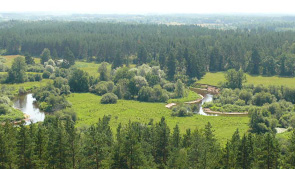Border regions support minimally affected ecosystem complexes that play an important role in Baltic conservation and improvement of biological and landscape diversity, as well as in strenghtening ecological integrity.
Abbreviation
Green Corridor / Zaļais koridors
Project identification Nr.
EU38806
Field
Nature protection, biotopes management
Implementation Area
South Estonia and North Vidzeme border region Natura 2000 sites.
- Latvia:
- Ziemeļgauja protected landscape area territory;
- nature reserves - Vadaiņi swamp, Bedne swamp, White marsh, Lepuri swamp, Melnsala swamp, Melnupe forests, Sloku swamp, Tetersala swamp;
- protected landscape area Veclaicene and included nature reserves Korneti-Peļļi, Avoti forest, Dēliņkalns;
- natural monument Kalamecu - Markūzu ravines;
- microreserves - Meldrupīte forest, Melnupe forest, Vidaga forest, Gaujiena swamp forest.
Demonstration Areas
Have not been planned
Project Funding Source
EST-LAT programme for 2007.-2013. year
ERAF, (Cross-border cooperation program European Structural Funds 3rd objective „European territorial cooperation” within year 2007.-2013.), program funding 83%.
Project Joint Funding
331 000 EUR (In Estonia 158 000 EUR, in Latvia 173 000 EUR), including funding from ERAF - 83%.
Project Lead Partner
Latvia: Nature Conservation Agency Vidzeme regional administration
Baznīcas iela 7, Sigulda, LV-2150, vidzeme@daba.gov.lv
Project Partners
Estonia: Estonia Environmental Board Polva-Valga-Voru region administration
Kristine Palm, Kristine.Palm@keskkonnaamet.ee;www.keskkonnaamet.ee
Project Duration
24 months (from 01.11.2011. to 31.10.2013).
Contact Persons
Manager: Sandra Ikauniece, +371 26532258, sandra.ikauniece@daba.gov.lv
Assistant: Laura Vīndedze, laura.vindedze@gmail.com
Project Web Page
Special web page not available
Project Short Description
Border regions support minimally affected ecosystem complexes that play an important role in Baltic conservation and improvement of biological and landscape diversity, as well as in strenghtening ecological integrity. Nature is our common value and species do not recognize borders, particularly in terms of migration. Therefore, a common understanding of the environmental situation and current trends is required, along with joint research and concerted action. Without a common understanding in the near future, the natural values in the border regions can disappear or be significantly threatened.
Therefore in 1st november, 2011 a project „Green Corridor” was started with the main goal of finding joint solutions for similar environmental problems.
Project Goal
A common environmental value data base to assist responsible decision-making, as well as to develop a mutually agreed management, monitoring and development activities in cross-border area.
Project Main Tasks
- Collection of existing information and to obtain new data, mapping of protected habitats and species in protected nature areas, as well as in important sites for species and habitats protection. Particular attention will be paid to the capercaillie, Great snipe, flying squirrel, Hermit beetle, European roller, river mussel,various species of butterflies and dragonflies inventory;
- Develop joint project site management plans and guidelines for activities for protected habitat practical management;
- Improvement measures for great snipe and capercaillie populated habitats, wooded meadow restoration, renovation of rivers and protection of biologically valuable trees from beaver damage;
- Monitoring of nature values, involving the local community and the public monitoring system using Internet webcasts;
- Evaluate the cross-border protected territory concept, potentials and management.
Planed Outputs
- The database will include information on protected species and habitats, a developed joint natural values management plan, as well as recommendations for rare species habitat management;
- Planned to improve capercaillie leking sites, by removal of trees and shrubs in a 55-ha area, management in wooded meadows in a 25-ha area, restoration of 3,25 km of river stretches with rapid flow and protect 500 biologically valuable trees from beaver damage;
- Substantial experience and knowledge of cross-border protected area governance and management organization will be obtained;
- Cooperation is planned with A / S "Latvian State Forests", the Latvian Fund of Nature, University of Latvia Faculty of Biology, Ornithological Society, Entomological society, involved region`s NGOs, municipalites representatives and land owners.
|
|




